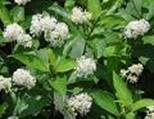| Kingdom | Plantae |
| Division | Magnoliophyta |
| Class | Magnoliopsida |
| Order | Rosales |
| Family | Rhamnaceae |
| Genus | Ceanothus |
| Species | C.americanus |
| Binomial name | Ceanothus americanus |
Other Common Names:
The other common names for the herb ceanothus are New Jersey tea, Redrot, Wild Snowball and Mountain Sweet.
History
Ceanothus americanus is versatile showy flowers are attractive in the formal perennial flower bed and the prairie meadow. New Jersey Tea is an attractive small rounded woody shrub and is sometimes called Snowball because of its small plumes of fluffy white flowers that bloom in early to mid-summer. New Jersey Tea grows best in well-drained average garden soil with full sun or partial shade but will tolerate dry, harsh conditions. It is a larval food source for the mottled Dusky-wing and Spring Azure Butterfly and is a nice addition to the butterfly garden.

Description
Ceanothus has a large root, with a red or brown epidermis, containing many small, white veins, and tolerably thick; body of the root dark-red. The stems are from 2 to 4 feet high, slender, suffruticose, with many reddish, round, smooth branches, the younger ones pubescent. The leaves are ovate or oblong-ovate, acuminate, serrate, 3-veined, rather smooth above, downy, with soft, reddish hairs beneath, and often heart-shaped at base. The flowers are minute, white, in long, crowded panicles from the axils of the upper leaves.


Range
This plant is very abundant in the United States, especially in the western portions thereof. It is confined to North America, the centre of its distribution in California, with few in the eastern United States and southeast Canada, and others extending as far south as Guatemala. New Jersey Tea is a native woody shrub occurring naturally in prairies, savannas, and limestone glades from Georgia to Texas, north to Indiana, Illinois, Iowa, and Kansas.
Habitat
This plant is usually seen around prairies, glades, open woods, thickets, railroads, sandy or rocky soils in clearings at the edge of woods, riverbanks or lakeshores, woodlands, and hillsides. Found in greatest abundance at high light intensities.
Cultivation
The preference is full or partial sun and average to slightly dry conditions. The soil can contain loam, rocks, or sand. This plant adds some nitrogen to the soil. Germination from seed can be slow and difficult - exposing them to hot water may be helpful. Transplants are easier to manage and faster to develop. Drought resistance is very good - under severe conditions, the leaves will become discoloured and shrivel, but quickly revive when rainfall returns. Foliar disease is rarely a significant problem. Seed are best sown as soon as it is ripe in a cold frame. Stored seed should be pre-soaked for 12 hours in warm water and then given 1 - 3 months stratification and germination usually takes place in 1 - 2 months at 20�c.The seed is ejected from its capsule with some force when fully ripe, timing the collection of seed can be difficult because unless collected just prior to dehiscence the seed is difficult to extract and rarely germinates satisfactorily. Prick out the seedlings into individual pots as soon as they are large enough to handle. Grow them on in the greenhouse for at least their first winter and plant them out into their permanent positions in late spring or early summer. The roots are quite brittle and it is best to pot up the callused cuttings in spring, just before the roots break. The seed exhibits considerable longevity, when stored for 15 years in an air-tight dry container at 1 - 5�c it has shown little deterioration in viability.
Flowering Season
The small white flowers in small clusters on axillary peduncle are in bloom from June through August.
Pests and Diseases
New Jersey tea is susceptible to leaf spot and powdery mildew; however no serious insect or disease problems exist.
Parts Used


The roots and leaves of the ceanothus are the most commonly used parts of the plant for its medicinal and commercial purposes.
Medicinal Applications

• An alkaloid from the root was used for increasing blood coagulability, especially the prevention of hemorrhage from surgery.
• The roots help in lowering blood pressure.
• The roots and leaves were boiled into tea and used for treating snake bites.
• The roots and root bark of New Jersey tea was used extensively to treat fevers and problems of the mucous membranes such as catarrh and sore throats.
• It is used in the treatment of asthma, bronchitis, coughs, dysentery, sore throats, tonsillitis and haemorrhoids.
• They also act as astringent, expectorant, haemostatic and sedative.
• A decoction of the bark is used as a skin wash for cancer and venereal sores.
• Ceanothus has been found to be a useful gastric, hepatic, and splenic stimulant, and it is in splenic troubles that its action is most favourable.
• For hepatic and splenic disorders the tincture of the leaves is preferred.
Commercial Applications
• Leaves were substitute for imported tea during the American Revolution.
• A green dye which is obtained from the flowers is used in some dyes and soap manufacturing.
• A cinnamon-coloured dye is obtained from the whole plant.
• The flowers are rich in saponins, when crushed and mixed with water they produce an excellent lather which is an effective and gentle soap.
• Ceanothus can be used as a body wash or to clean clothes.

The flowers were much used by the North American Indians as a body wash, especially by the women in preparation for marriage, and they leave the skin smelling fragrantly of the flowers. It was much used during the Civil War for malarial splenitis.When the redroot (Ceanothus americanus) puts forth its leaves the people say the young fawns are then in the mountains. On the buffalo hunt when timber was scarce, the great gnarled woody roots of this shrub, often much larger than the part above ground were used for fuel.